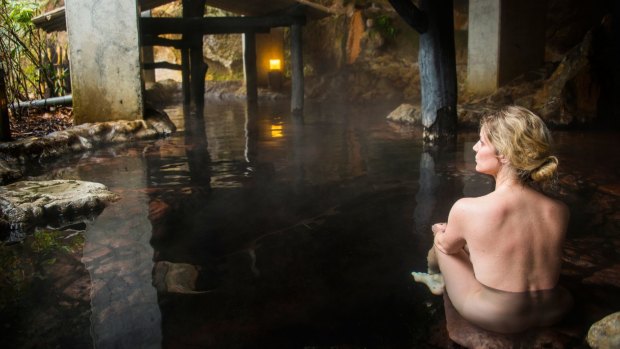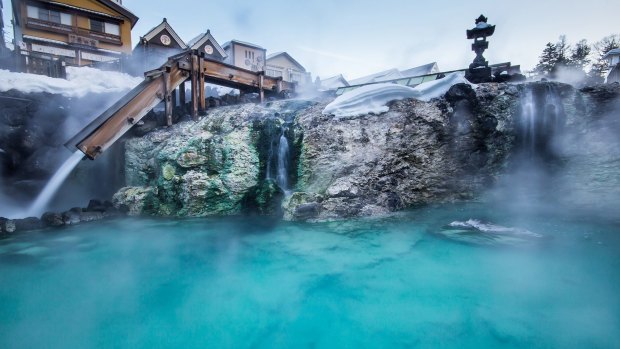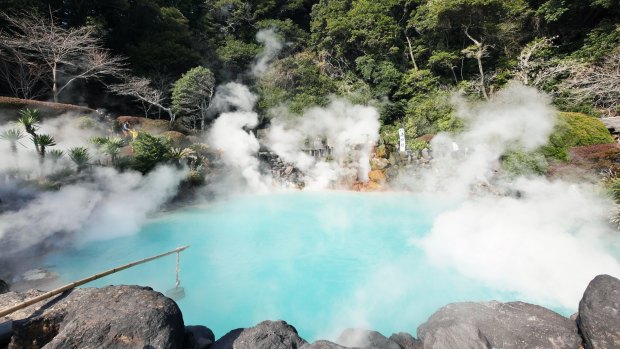This was published 5 years ago
Onsens in Japan for tourists: The rules of visiting an onsen
By Brian Johnston

A public onsen in Kyushu. There are more than 2000 in Japan.Credit: Alamy
I'm all for riding bullet trains, enjoying the bright lights of Tokyo and attending the sumo wrestling when in Japan, but I reckon a visit to an onsen or hot-spring resort is the country's top cultural experience. You'll find onsen everywhere, and they don't just provide you with a wash and a wallow. You get an intimate experience of a distinctive cultural habit, too, and after a while might begin to see why onsen have such a central place in the imagination and daily rituals of the Japanese.
There are more than 2000 onsen in Japan, officially defined as places where geothermally heated water emerges from the ground at a temperature of 25 degrees Celsius or more. If baths are supplied only by heated tap water then they are called sento rather than onsen, although you may not discern much difference. No two are exactly the same.
One onsen might be a mountain pool beside a simple hillside hut, another a huge resort replete with hotels, water slides and a dozen baths loud with company employees indulging in a weekend of boozy bonding. Many are housed inside ryokan (traditional inns) and might consist of a wooden tub or two.

The Japanese visit onsen partly as a social habit, partly because dissolved minerals in the water are thought to impart medical benefits, assuaging everything from rheumatism to high blood pressure.Credit: SHUTTERSTOCK
The Japanese visit onsen partly as a social habit, partly because dissolved minerals in the water are thought to impart medical benefits, assuaging everything from rheumatism to high blood pressure. Principally, though, they offer relaxation after a long day of business or sightseeing, and are an antidote to stress. Sit up to your neck in soothing warm water and meditate on a distant view of snow-capped mountains or autumn trees, and you might appreciate why the Japanese are onsen fanatics.
Still, for the foreign visitor a first-time visit to an onsen is fraught with its own stress. Don't be worried. While ritualised bathing has its roots in Confucian and Shinto philosophy, and is supposed to have rules as arcane as any tea ceremony, even most Japanese are oblivious to the onsen's thousand-year-old traditions. In fact, you can get by just by following a few simple rules, nearly all of which aim to keep the onsen water as clean as possible.
You pay your entry at the door, where you also rent towels if they aren't included in the entry fee. Remove your shoes immediately, certainly before entering the changing room. It's then that you'll encounter the major challenge of onsen life: leaving your clothes, inhibitions and large drying towel behind in a locker. All you take into an onsen is your locker key, attached to a rubber band that you put around your ankle or wrist.
Nudity is not negotiable, so you needn't try to smuggle your budgies.
Historically, both sexes bathed together, but these days all but the smallest rural onsen are divided into male and female sections. Nudity is not negotiable, so you needn't try to smuggle your budgies. You have a small hand towel, which must double as a fig leaf if you insist. Once you're in the pools, your hand towel can sit on the surrounding edge or on top of your head, but never in the water. Nor should you dip your hair in onsen water, so tie it up if it's long.
If communal nudity isn't for you (or you have tattoos, which are banned in most public facilities thanks to their association with criminal gangs), then some onsen have private bathing rooms. Luxury ryokans might have en suite sento baths attached to your room.
Get over it, though. Onsen users are used to naked people. Actually, you're most on display before you clamber into the onsen itself. First you must have a long, serious public wash, a ritual that might take a good 20 minutes. This is performed in the most ignominious naked position imaginable, squatting on a low wooden stool in front of a tap, and using a wooden scoop. Sit rather than stand to avoid splashing neighbours. Soap and shampoo is usually provided.

One onsen might be a mountain pool beside a simple hillside hut, another a huge resort replete with hotels, water slides and a dozen baths.Credit: SHUTTERSTOCK
On one level this is about washing before you hop into a communal pool, so make sure you're sparkling clean (and soapless) before you take the onsen plunge. You should also rinse off again each time you clamber back in (for example, after using steam rooms).
On another level, the Japanese say this is as much about cleansing your soul as your physical body as you wash away the stresses of the day. Abandon thoughts about what your derriere looks like, and just enjoy the moment.
It's finally time to immerse yourself in the onsen. If the water is very hot, you should only stay in for a short period, as prolonged immersion is bad for your health. Signs, unfortunately often only in Japanese, recommend soaking times. Normally, patrons alternate between hotter and cooler baths, and between indoor and outdoor ones if there are both. Alcohol and hot onsens are a bad mix but, in any case, you should never drink or eat in an onsen.
As you float in the water and breathe in the steamy air, your muscles relax and your mind unwinds. Patrons sit with their eyes downcast, not only for modesty's sake but because onsen seem to bring on meditative moods. Be lulled and feel Zen, because the only ordeal left is a naked retreat back to the changing rooms.
FIVE PLACES TO ONSEN
1. BEPPU
This coastal town gets 12 million onsen tourists annually, with rollicking visitors combining bathing with bars, strip shows and karaoke singing. It's bawdy and tacky, but there are hundreds of hot springs (though not all for bathing), some featuring spectacular boiling orange mud and gushing vents. See en.visit-oita.jp
2. DOGO
This ancient onsen in Matsuyama is immortalised in Japanese literature and art, and is now on Japan's Important Cultural Property list. There are many bathhouses around town, but the main Dogo Onsen Honkan is venerable in wood and has a section reserved for the imperial family. See dogo.or.jp
3. GERO
The silky, perfumed waters in this town in Japan's central mountains are said to be especially good for youthful skin. Three public and many private onsen are dotted around town, with a tourist spa pass allowing access to some 30 of them. You can also dip your extremities into hand and foot baths. See gero-spa.or.jp
4. NOBORIBETSU
Located in Hokkaido – perfect for a winter wallow as snow falls – Noribetsu sits in a beautiful valley coloured by mineral deposits. Onsen aficionados appreciate the 11 types of mineralised water and wide choice of facilities, including the famous Daiichi Takimotokan bathhouse. See noboribetsu-spa.jp
5. KUSATSU
One of the country's most famous onsen resorts, often nominated in top place in public polls in Japan, has open-air baths, plus many others in excellent ryokans. The vast central Yubatake or Hot-Spring Field gushes boiling water, cooled in a daily traditional ceremony accompanied by singing. See kusatsu-onsen.ne.jp
Brian Johnston travelled courtesy of Japan National Tourism Organisation and several regional tourism offices and hotels.
TRIP NOTES
TOUR
Inside Japan Tours specialises in small-group and self-guided tours that often include onsen visits. Phone (07) 3703 3838, see insidejapantours.com
See also: Twenty things that will surprise first-time visitors to Japan
Sign up for the Traveller Deals newsletter
Get exclusive travel deals delivered straight to your inbox. Sign up now.